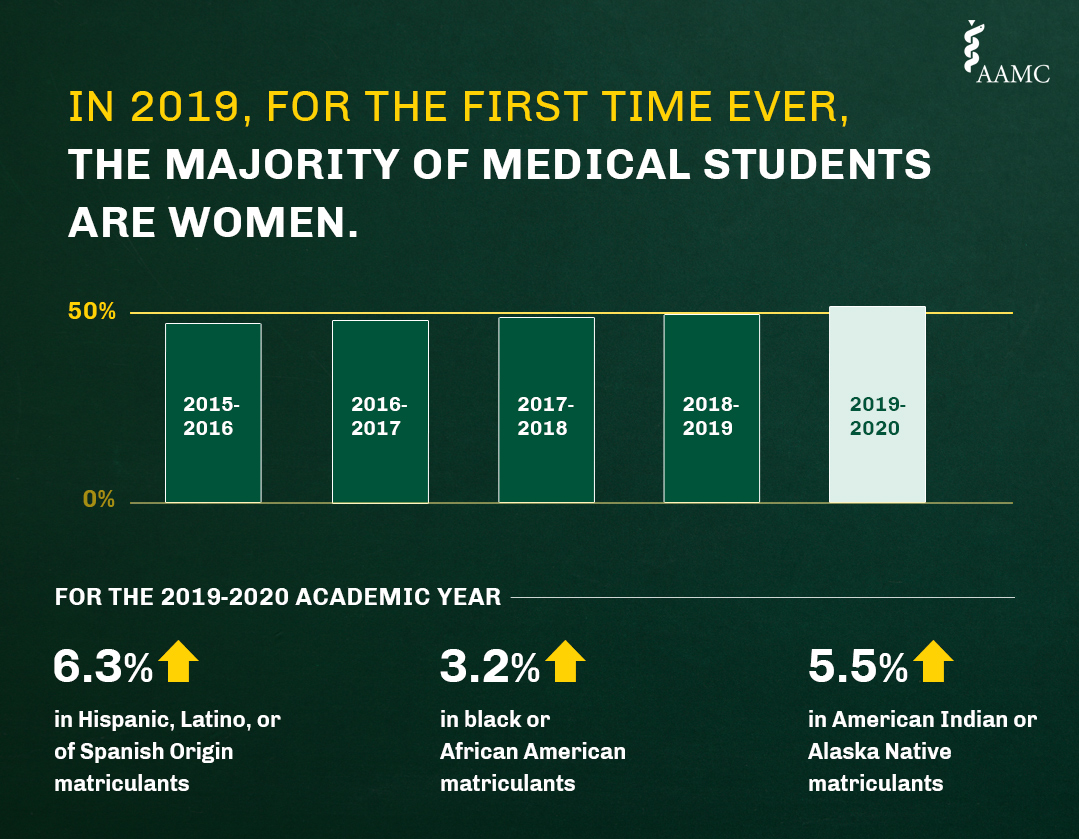Women comprise the majority of enrolled U.S. medical students for the first time, according to 2019 data released today by the AAMC (Association of American Medical Colleges). This progress builds on the milestone reached in 2017, when, for the first time, women comprised the majority of first-year medical students.
The proportion of women students has been rising over recent years, from 46.9% in 2015 to 49.5% in 2018. In 2019, women comprise 50.5% of all medical school students.
The number of applicants to medical schools rose by 1.1% from 2018 to 2019, to a record 53,371, and the number of matriculants (new enrollees) grew by 1.1%, to 21,869. Across applicants and matriculants, the number of women increased while the number of men declined.
The 2019 data also show that the nation’s medical schools continue to make modest gains in attracting and enrolling more racially and ethnically diverse classes, although these groups remain underrepresented in the overall physician workforce.
- Applicants who are Hispanic, Latino, or of Spanish origin increased 5.1%, to 5,858, and matriculants from this group grew 6.3%, to 2,466.
- The number of black or African American applicants rose 0.6%, to 5,193, and matriculants increased by 3.2%, to 1,916. Among black or African American men, applicants and matriculants increased 0.5%, and the total enrollment of black or African American men rose 3.7%, to 3,189.
- American Indian or Alaska Native applicants grew by 4.8%, to 586, and matriculants rose 5.5%, to 230.
“The steady gains in the medical school enrollment of women are a very positive trend, and we are delighted to see this progress,” said David J. Skorton, MD, AAMC president and CEO. “However, the modest increases in enrollment among underrepresented groups are simply not enough. We cannot accept this as the status quo and must do more to educate and train a more diverse physician workforce to care for a more diverse America.”
The continued growth in the number of applicants to U.S. medical schools demonstrates that interest in a career in medicine remains high, which is crucial as the nation faces a projected shortage of up to 122,000 physicians by 2032. To address this shortage, medical schools have expanded class sizes, 20 new schools have opened in the past decade, and the total number of enrolled medical students has grown by 33% since 2002.
But to increase the overall supply of U.S. physicians to meet the needs of America’s growing and aging population, Congress must increase the number of federally funded residency training positions. The AAMC supports bipartisan legislation that would add 15,000 residency slots over five years to ensure that all patients have access to the care they need.
As in previous years, medical school enrollees in 2019 had strong academic credentials, with an average undergraduate GPA of 3.78. Enrollees range in age from 15 to 53, and 131 are military veterans. Additionally, this year’s entering class demonstrates a strong commitment to service, cumulatively performing more than 14 million community service hours.
Data tables are available here.
Editor's Note: The race/ethnicity data include individuals who identified in one or more race/ethnicity categories. For example, “black or African American” includes individuals who identified only as black or African American as well as those who identified as black or African American and at least one other race/ethnicity category.
The Association of American Medical Colleges is a not-for-profit association dedicated to transforming health care through innovative medical education, cutting-edge patient care, and groundbreaking medical research. Its members comprise all 154 accredited U.S. and 17 accredited Canadian medical schools; nearly 400 major teaching hospitals and health systems, including 51 Department of Veterans Affairs medical centers; and more than 80 academic societies. Through these institutions and organizations, the AAMC serves the leaders of America’s medical schools and teaching hospitals and their 173,000 faculty members, 89,000 medical students, 129,000 resident physicians, and more than 60,000 graduate students and postdoctoral researchers in the biomedical sciences. Additional information about the AAMC and its member medical schools and teaching hospitals is available at www.aamc.org.
